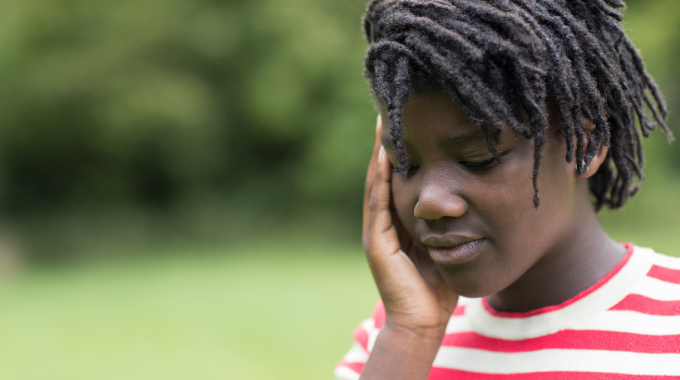Written by Kate Sheehan, LCSW
Many children have anxiety that gets in the way of everyday functioning, and some of those children have parents who will divorce. While all kids will face problems during a divorce, these issues can be even worse for children already struggling with anxiety, and these issues can mark a particularly critical point in a child's emotional and social development.
What Is Anxiety?
Anxiety is the most common mental health challenge for both children and adults. Anxiety can be induced in any of us as a reaction to specific people, events, or activities. These can range from speaking in class or performing in public, to taking an important test, to seeing a big dog. Although anxiety can attach to any of these specific instances, it tends to be more general and persistent in our thoughts, actions, physical sensations and emotions. For those with more serious forms of anxiety, anxiety becomes a way of thinking, doing, or feeling, regardless of what is actually happening.
We often think about anxiety in terms of:
- Physical symptoms (headaches and stomachaches are especially common)
- Cognitive symptoms (worrying, "catastrophizing," and/or thinking in terms of all-or-nothing)
- Behavioral symptoms (clinging, crying, avoiding)
Kids may work hard to avoid situations or tasks that bring on these uncomfortable symptoms.
How Divorce Can Make Children Anxious
Divorce might not necessarily be the sole cause of a child’s anxiety, but the overall experience of divorce may be a great source of stress for the family as a whole. For example, family members may need to adjust to new living arrangements and routines, or they may struggle to navigate new ways of communicating.
Here are some suggestions to lessen anxiety during a divorce:
1. Practice self-care as a parent.
Research has shown that a parent’s reaction to divorce is a major factor in the way the child reacts to it. The more anxious a parent is, the more anxious the child will be. Find help in managing your own fears, including worries about your child’s safety and wellbeing, so your child can also find a way to be less worried.
2. Establish a consistent routine.
As schedules, responsibilities, and living arrangements change, stress levels are sure to rise. Routines, rituals, predictability, and control are crucial for children going through stressful transitions, especially those with anxiety. Creating structure and consistency is critically important.
3. Communicate with your ex about your child’s needs.
Even in the most amicable of divorces, signs of your child’s struggles (e.g., anxiety, increased physical complaints, extra clinginess, excessive worry, avoidance) might get lost in the chaos of two different households. It can be especially difficult to detect avoidance as a symptom of anxiety during these transitions. Parents may misread cues, minimize a pattern, or even attribute these difficulties to changes in the family. It is important that parents communicate with one another effectively about their expectations for each child and their concerns about each child’s behavior.
Families should communicate with one another about the past family routines and rituals each member wants to maintain from when the family lived together. Brainstorming ideas of new family rituals or routines can also be helpful. Using a shared calendar and communication tools can cut down on misunderstandings, mistakes about commitments, and ensuing arguments.
4. Maintain structure and reassurance for your child.
Uncertainty is the gasoline on the fire of anxiety. Anxious youth may ruminate about uncertainties around:
- Living arrangements (e.g., “Where will I live?” “What about my room and toys?”)
- Caregiver support (e.g., “Who will take care of me and my siblings?”)
- Family relationships (“Will my mom/dad be okay without the other?” “Will my parents remarry or have more kids?”)
- Sense of belonging (“If my parents remarry will I fit in?”)
- Love (“If my parents can stop loving each other, does that mean they can stop loving me?” “Do my parents love me?”)
Though you may be tempted to provide blanket reassurances to an anxious child, try to stick with what you know and believe to be true. If you know what the living arrangements will be, say so. If not, be honest and describe what you plan to do to figure it out. Children can benefit from even the smallest amount of truth that you can offer. You don’t need to know everything that’s going to happen next, just start with what you do know. As families go through stressful events or transitions, having tools for effective family communication can promote openness, support, and dialogue about each family member’s experience.
5. Reduce conflict wherever possible.
Research shows that conflict between parents (married, divorced, or otherwise) is more damaging to a child’s long-term wellbeing than the actual divorce is. Exposure to marital conflict has been associated with several negative outcomes for children, including depression, poor functioning and well-being, poor school performance, and even marital problems later in life. When done responsibly and carefully, ending a toxic marriage can be the best parenting decision possible. In fact, offspring from homes with high levels of marital conflict (prior to divorce) reported greater wellbeing in early adulthood if their parents divorced compared to those whose parents stayed married (Amato, Loomis & Booth, 1995).
6. Model empathy for your children.
As with other major family incidents, a divorce may be experienced very differently by each family member. As a parent, you have the opportunity to protect your child’s unique experience of shared events. When we are deep in our own experience, it can be difficult to recognize what others are going through, especially when it differs from what we’re going through. For example, while your sadness or anger may be the strongest emotions early in the divorce, one child may be feeling more relief that family tensions will soon be resolved while another worries that they will not be loved. Try to stay open to seeing the experience through your child’s eyes. Try to recognize that divorce is a grief process for children and parents alike. Each family member may move through the stages of grief (denial, anger, bargaining, depression and acceptance) in a different order and at different speeds. As children grow older, they may need to process the divorce again at different stages in their lives. These stages can include pivotal life moments such as when they have their first romantic relationship, get married, or have children.
Communicating about your grief process and feelings is helpful to model both emotion regulation and healthy means of coping. For example, a father may recognize that he’s feeling irritable and that he would like to watch a funny movie to feel better. A mother may share that she’s feeling sad, identify that she’d like to cuddle, then name how she feels better after using a coping skill. (“Thanks for the cuddle. I always feel happier when we spend time together.”)
7. Set boundaries between you and your children.
Setting boundaries means not treating your child as your therapist, spy, or the mini-me of your (soon to be) ex. This can get very difficult. Make sure you have a support system in place (friends, a therapist, a support group) that allows you to vent, cry, rage, complain, and express all of your difficult emotions. This will lessen the burden on your kids to manage those emotions for you, or even feel the pressure to share the same feelings and experiences as you.
8. Show your children that there is hope.
Nobody undertakes a divorce so their lives will be worse. Yet, we can lose sight of hope for a better, happier, and more peaceful life amidst the chaos of all of the transitions and changes. Practicing gratitude as a family can help you focus on the positive. Gratitude practices can also be effective medicine for the negativity bias that can feed anxiety. When you’re with your kids, make a habit of naming at least one thing aloud each day that you are grateful for over dinner or in the car on the way home from school.
Other protective factors for children include positive communication, strong parent-child relationships, mentors or supportive caregivers, and a sense of school belonging. Focusing on what is going well will help everyone, including your anxious child, balance worries and uncertainties as you move into a new life together.
Next Steps in Managing Divorce Anxiety
Remember, typical worries or anxieties come and go. Other more serious forms of anxiety typically last longer than they should, get in the way of normal tasks, and can cause disruptions in family communication or routines. If you would like more information about signs of an anxiety disorder, ways to support your child, and professionals who can help, read more articles on the It’s Over Easy Insights Blog, or visit our website.
About the Author:
Kate Sheehan, LCSW is Managing Director at the UCLA Center for Child Anxiety Resilience Education and Support.
Go to this page about online divorce to learn more.




Comments